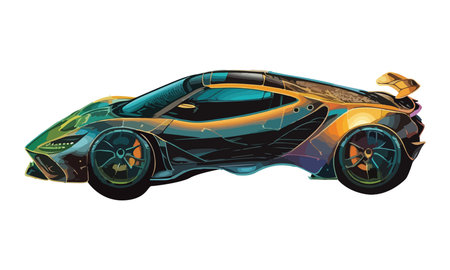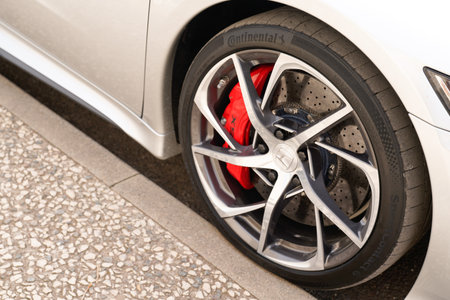1. Introduction to Aerodynamics in Automotive Engineering
When designing a vehicle, one of the most important factors engineers consider is aerodynamics. Aerodynamics is the study of how air moves around objects, and in the world of automotive engineering, its a key factor in vehicle performance, fuel efficiency, and stability.
What is Aerodynamics?
Aerodynamics refers to the way air flows around a vehicle. The shape, size, and design of a car all play a role in determining how smoothly air moves around it. A well-designed aerodynamic vehicle experiences less air resistance, which improves speed, fuel efficiency, and handling.
Why is Aerodynamics Important in Vehicle Design?
Engineers focus on aerodynamics for several reasons:
- Reducing drag: Less air resistance means better fuel efficiency and higher speeds.
- Improving stability: Aerodynamics affects how well a car stays on the road at high speeds.
- Enhancing handling: Proper airflow can improve steering response and overall drivability.
Key Aerodynamic Factors
There are several critical factors in aerodynamics that impact vehicle design:
| Aerodynamic Factor | Effect on Vehicle |
|---|---|
| Drag | Resistance that slows a vehicle down |
| Downforce | Increases traction and stability |
| Lift | Can reduce stability at high speeds |
| Turbulence | Causes air disturbances that affect performance |
Aerodynamics and Real-World Vehicle Performance
Automakers invest heavily in wind tunnel testing and computer simulations to optimize vehicle aerodynamics. Whether its a sleek sports car or a fuel-efficient sedan, the science of airflow plays a major role in how a car performs on the road.
2. The Principles of Airflow and Drag
Understanding how air moves around a vehicle is key to improving its efficiency and performance. Several aerodynamic forces influence how a car interacts with the air, including drag, lift, and downforce. Each of these forces plays a role in determining how smoothly, quickly, and efficiently a vehicle can travel.
What Is Drag?
Drag is the force that opposes a vehicle’s forward motion. When a car moves, it pushes through the air, creating resistance that slows it down. The greater the resistance, the more energy the vehicle needs to maintain speed, which affects fuel efficiency and performance.
Types of Drag
There are several types of drag that impact vehicles:
| Type of Drag | Description |
|---|---|
| Parasitic Drag | Resistance caused by air friction and turbulence. |
| Form Drag | Drag produced by the shape of the vehicle, influencing how air flows around it. |
| Skin Friction Drag | Created by air molecules interacting with the vehicles surface. |
| Induced Drag | Occurs due to the creation of lift, typically more relevant to airplanes but still affecting cars with aerodynamic wings. |
How Lift Affects Vehicle Stability
Lift is the force that pushes a vehicle upwards, similar to how an airplane generates lift to stay in the air. However, for cars, uncontrolled lift can be dangerous because it reduces traction on the road. A well-designed vehicle minimizes unwanted lift to improve stability at high speeds.
The Importance of Downforce
Downforce is the opposite of lift. It pushes the car downward, increasing grip between the tires and the road. Race cars and high-performance vehicles use spoilers and airfoils to generate downforce, allowing them to maintain control at high speeds.
How Downforce Benefits Performance
- Improves tire traction
- Enhances cornering ability
- Increases overall stability at high speeds
Balancing Aerodynamic Forces
Manufacturers design vehicles with a balance of drag, lift, and downforce to maximize efficiency and performance. Reducing drag improves fuel economy, while managing downforce ensures stability. Understanding these forces helps engineers create more aerodynamic vehicles that perform better on the road.

3. How Aerodynamics Affects Speed and Fuel Efficiency
When a vehicle moves, it has to push through the air. This creates air resistance, also known as drag. The more aerodynamic a car is, the less drag it experiences, which directly impacts its speed and fuel efficiency.
Understanding Air Resistance
Air resistance increases with speed. As a vehicle moves faster, the air pushing against it becomes stronger, requiring more energy to maintain speed. This is why performance cars and fuel-efficient vehicles are designed with sleek shapes to reduce drag.
How Drag Affects Fuel Consumption
A vehicle’s engine must work harder to overcome air resistance, which means using more fuel. The higher the drag coefficient, the greater the fuel consumption at highway speeds. Here’s a comparison of how aerodynamics affect fuel efficiency:
| Vehicle Type | Drag Coefficient | Fuel Efficiency at Highway Speeds (mpg) |
|---|---|---|
| Sports Car | 0.30 | 25-30 |
| SUV | 0.35-0.45 | 15-22 |
| Hybrid Sedan | 0.25 | 45-55 |
Impact on Vehicle Top Speed
Drag also limits a vehicle’s top speed. At high speeds, aerodynamic resistance becomes the primary force a car must overcome. That’s why race cars have low drag designs and specialized aerodynamics, like spoilers and diffusers, to manage airflow efficiently.
Reducing Drag for Better Performance
Manufacturers and engineers improve aerodynamics by designing cars with smooth curves, underbody covers, and active grille shutters. Even small changes, like keeping windows closed or removing roof racks, can enhance fuel efficiency and speed.
4. Aerodynamic Design Features in Modern Vehicles
Automakers use various aerodynamic design features to optimize airflow around a vehicle, improving fuel efficiency, handling, and overall performance. Some of the most common components include spoilers, diffusers, and air skirts. These elements help reduce drag and enhance stability at high speeds. Below, we examine how each of these features contributes to better aerodynamics.
How Spoilers Improve Airflow
Spoilers are designed to disrupt airflow in a way that reduces turbulence and drag. They work by redirecting air over or around specific areas of a vehicle, often improving downforce and stability. A well-designed spoiler can help sports cars maintain grip on the road at high speeds, while also benefiting fuel efficiency in certain vehicle designs.
Types of Spoilers
| Spoiler Type | Function |
|---|---|
| Rear Spoiler | Enhances downforce and reduces drag at high speeds |
| Front Spoiler (Air Dam) | Minimizes air flowing underneath the vehicle to reduce lift |
| Active Spoiler | Adjusts automatically to optimize airflow based on speed |
The Role of Diffusers in Aerodynamics
A diffuser is located at the rear of a vehicle, usually beneath the bumper. It works by accelerating the airflow under the car, reducing pressure and creating a suction effect to increase stability. This helps enhance traction and handling, making diffusers common in performance cars and racing vehicles.
How Diffusers Work
Diffusers operate by expanding the air that flows underneath the vehicle, allowing it to exit smoothly. This reduces turbulence and drag while improving overall aerodynamic efficiency. Many high-performance vehicles incorporate diffusers with vertical fins, which help channel the airflow more effectively.
Air Skirts and Their Benefits
Air skirts, also known as side skirts, improve aerodynamics by directing airflow along the sides of a vehicle, preventing air from spilling underneath and causing drag. By managing airflow in this way, air skirts enhance stability, fuel efficiency, and even reduce road noise.
Why Modern Vehicles Use Air Skirts
- Reduces drag for improved fuel efficiency
- Minimizes air turbulence along the sides of the vehicle
- Enhances high-speed stability
These aerodynamic design features work together to optimize vehicle airflow, ultimately improving performance and efficiency. As automotive technology advances, expect to see even more innovative solutions aimed at perfecting vehicle aerodynamics.
5. The Future of Automotive Aerodynamics
As automotive technology continues to evolve, aerodynamics is becoming a key focus for improving vehicle performance. Innovations in active aerodynamics and the development of new materials are pushing the boundaries of efficiency, speed, and stability.
Advancements in Active Aerodynamics
Active aerodynamics refers to components that adjust in real-time to optimize airflow and performance. Unlike traditional fixed aerodynamic elements, these systems respond dynamically to driving conditions to enhance efficiency and handling.
Common Active Aerodynamic Features
| Feature | Function | Benefit |
|---|---|---|
| Active Grille Shutters | Open and close to regulate airflow | Improve fuel efficiency by reducing drag |
| Adjustable Rear Spoilers | Change position based on speed | Increase downforce for better stability |
| Deployable Front Splitters | Extend at high speeds | Enhance cornering grip and reduce lift |
| Rear Diffuser Adjustments | Modify airflow under the vehicle | Reduce turbulence and increase efficiency |
The Role of New Materials
The materials used in automotive design significantly impact aerodynamic performance. Lightweight and strong materials help reduce weight while maintaining structural integrity, leading to better efficiency.
Innovative Materials Enhancing Aerodynamics
- Carbon Fiber: Extremely lightweight and strong, reducing overall weight and improving speed.
- Aluminum Alloys: Lighter than steel but still durable, offering better weight distribution.
- Active Aero Materials: Smart materials that can change shape to optimize aerodynamics in real-time.
Shaping the Future
As research continues, vehicles will integrate increasingly advanced aerodynamic technologies. From active air management systems to shape-shifting materials, the future of automotive aerodynamics is geared toward achieving maximum speed, efficiency, and safety while reducing energy consumption.


